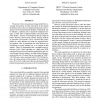Free Online Productivity Tools
i2Speak
i2Symbol
i2OCR
iTex2Img
iWeb2Print
iWeb2Shot
i2Type
iPdf2Split
iPdf2Merge
i2Bopomofo
i2Arabic
i2Style
i2Image
i2PDF
iLatex2Rtf
Sci2ools
ICMCS
2006
IEEE
2006
IEEE
Video News Shot Labeling Refinement via Shot Rhythm Models
We present a three-step post-processing method for increasing the precision of video shot labels in the domain of television news. First, we demonstrate that news shot sequences can be characterized by rhythms of alternation (due to dialogue), repetition (due to persistent background settings), or both. Thus a temporal model is necessarily thirdorder Markov. Second, we demonstrate that the output of feature detectors derived from machine learning methods (in particular, from SVMs) can be converted into probabilities in a more effective way than two suggested existing methods. This is particularly true when detectors are errorful due to sparse training sets, as is common in this domain. Third, we demonstrate that a straightforward application of the Viterbi algorithm on a third-order FSM, constructed from observed transition probabilities and converted feature detector outputs, can refine feature label precision at little cost. We show that on a test corpus of TRECVID 2005 news videos...
| Added | 11 Jun 2010 |
| Updated | 11 Jun 2010 |
| Type | Conference |
| Year | 2006 |
| Where | ICMCS |
| Authors | John R. Kender, Milind R. Naphade |
Comments (0)

